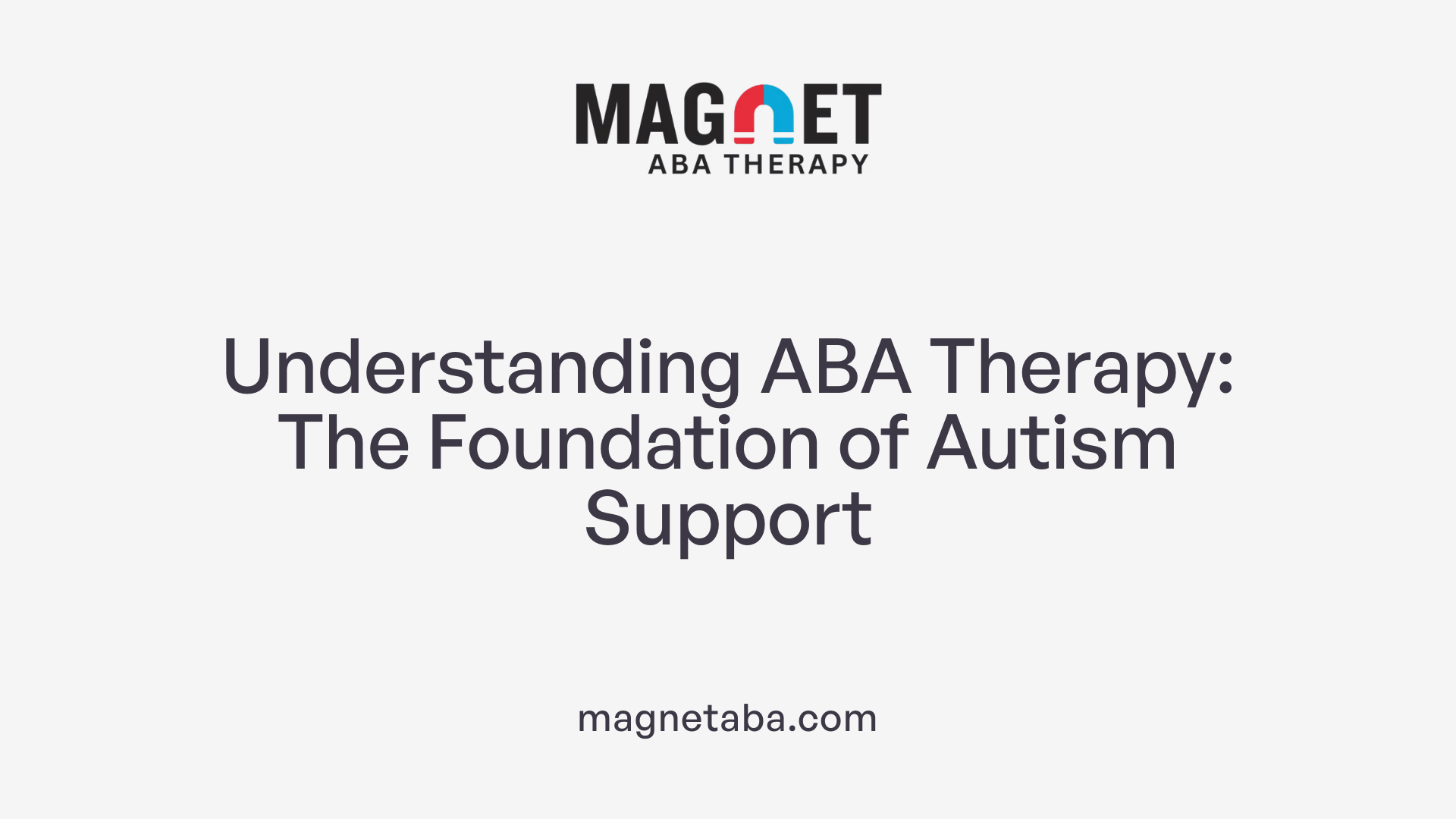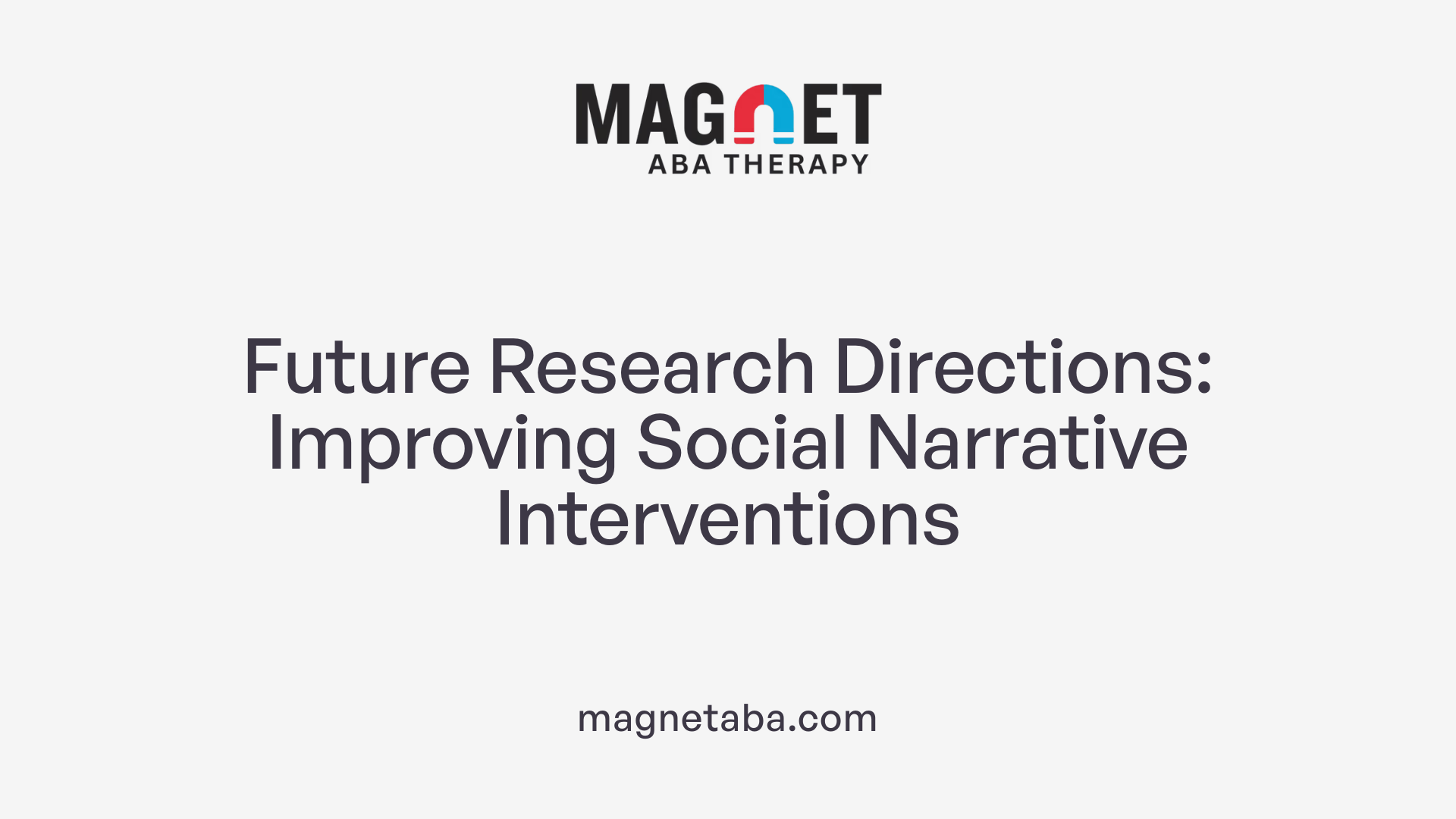Introduction to Social Scripts in Autism Support
Navigating new social situations can be challenging for individuals with autism spectrum disorder (ASD), often leading to anxiety, confusion, or disruptive behaviors. One effective strategy used within Applied Behavior Analysis (ABA) therapy to ease these transitions and improve social understanding is the use of social scripts, also known as social narratives or social stories. Originating from Carol Gray's pioneering work, these stories provide clear, positive, and personalized guidance to help individuals comprehend social expectations and develop adaptive behaviors. This article explores how social scripts support new situations, their role within ABA therapy, the professionals who deliver these interventions, their benefits, ethical considerations, and avenues for future research.
The Foundations of ABA Therapy in Autism Support

What is Applied Behavior Analysis (ABA) therapy, and how is it used to support individuals with autism?
Applied Behavior Analysis (ABA) therapy is a scientifically grounded approach that focuses on understanding and modifying behavior through environmental influences. It is widely recognized as an effective intervention for individuals with autism spectrum disorder (ASD).
ABA therapy aims to increase positive behaviors such as communication, social skills, and daily living activities, while decreasing undesired behaviors like aggression or off-task actions. This is achieved by techniques including positive reinforcement, task analysis, and careful assessment of the events that precede and follow behaviors.
Individualized ABA programs are designed by qualified behavior analysts and tailored to each person’s unique needs. These programs can be delivered in diverse environments such as homes, schools, or community settings to ensure practical and generalized learning.
Structured teaching methods, such as Discrete Trial Training, natural environment teaching, and social narratives, support skill acquisition across multiple developmental domains. Intensive and early intervention through ABA has been shown to improve language, social interaction, and adaptive behaviors significantly.
The evidence base for ABA therapy is strong, establishing it as a cornerstone in autism support worldwide. Its systematic approach empowers individuals with ASD to enhance their independence and quality of life through skill building and behavioral improvement.
The Role of Practitioners in Delivering ABA Therapy
Qualifications of ABA Providers
ABA therapy is most commonly delivered by specialized professionals who have undergone extensive training and certification. The primary providers include Board Certified Behavior Analysts (BCBAs) and Registered Behavior Technicians (RBTs). BCBAs usually hold a master's degree in behavior analysis or a closely related field. Their training includes comprehensive supervised experience, requiring approximately 1,500 to 2,000 hours of practical work.
Certification is a critical component in validating a professional's expertise. The Behavior Analyst Certification Board (BACB) administers the BCBA® exam, a standard credential that ensures providers meet rigorous competencies. In certain states, practitioners must also obtain licensure, involving additional regulatory exams and application procedures to legally practice ABA therapy.
Types of Professionals Involved in ABA Therapy
Aside from BCBAs and RBTs, individuals with backgrounds in psychology, education, speech therapy, or occupational therapy may also participate in delivering ABA interventions. These professionals collaborate to devise and implement tailored treatment plans using techniques such as positive reinforcement, modeling, and social narratives to support individuals with autism spectrum disorder and other developmental challenges.
ABA therapists work in diverse environments, including schools, clinics, homes, and community settings, adapting their approach based on each individual's needs. Their qualifications and specialized training enable them to apply evidence-based methods effectively, ensuring interventions are both safe and beneficial.
Understanding and Tailoring ABA Interventions
How Does ABA Therapy Assess and Tailor Interventions Specific to Each Individual's Needs?
ABA therapy begins with a thorough assessment process to understand an individual's unique strengths, challenges, and developmental stage. This involves various methods such as direct observation, interviews with caregivers, standardized tests, and functional assessments. These provide a detailed picture of behaviors and skills that require support or development.
From this initial evaluation, therapists collaborate with families and other professionals to set clear, personalized goals. These goals follow the SMART criteria (Specific, Measurable, Achievable, Relevant, Time-bound), focusing on areas such as communication, social interactions, self-care, and daily living skills.
During therapy, ongoing, systematic data collection is vital. Techniques may include frequency counts of specific behaviors, ABC (Antecedent-Behavior-Consequence) recording, and progress charts. This data-driven approach allows therapists to monitor effectiveness and make informed adjustments to strategies and goals.
Family involvement plays a crucial role in ensuring that learning and behavior changes generalize beyond therapy sessions into everyday life. Educating caregivers about intervention strategies supports consistency and reinforcement in natural settings.
Overall, ABA interventions are dynamic. Regular reviews and flexibility ensure treatments adapt to the individual's evolving needs, fostering continuous growth and skill mastery.
Key Goals and Benefits of ABA Therapy for Autism
What Are the Primary Goals and Benefits of ABA Therapy for Individuals with Autism?
ABA (Applied Behavior Analysis) therapy is widely recognized for its comprehensive approach in supporting individuals with autism. The primary objectives focus on fostering crucial skills such as communication, social interaction, self-care, and academic abilities. Alongside developing these skills, ABA targets the reduction of challenging behaviors, helping individuals better navigate their environments.
The therapy is designed to enhance independence by promoting daily living skills and improving overall quality of life. ABA’s individualized treatment plans are crafted based on each person's unique needs, interests, and abilities, ensuring targeted and effective learning experiences.
Behavioral and Skill Development Goals
ABA therapy uses evidence-based techniques like positive reinforcement and naturalistic teaching to support skill growth. These methods can lead to meaningful progress in language acquisition and social skills, enabling individuals to engage more fully in home, school, and community settings.
Improvements in Communication and Social Skills
By focusing on social behavior and effective communication, ABA helps individuals initiate interactions, understand social cues, and express themselves more clearly. This fosters better relationships and increases success in group activities and everyday social situations.
Enhancement of Independence and Quality of Life
Through consistent practice and reinforcement, ABA supports the development of self-care and adaptive behaviors. This empowerment helps individuals gain confidence and autonomy, contributing to a more enriched and satisfying life.
Overall, ABA therapy offers a structured yet flexible approach that can lead to significant and lasting improvements, promoting greater inclusion and participation across various environments.
Introduction to Social Narratives: Social Stories
What Are Social Stories and Who Developed Them?
Social stories, also called social narratives, are personalized short passages designed to help individuals with autism spectrum disorder (ASD) understand and navigate social situations. These stories were introduced by Carol Gray in 1991 as a supportive tool to enhance social comprehension and reduce anxiety in individuals with ASD.
What Is the Purpose and Structure of Social Stories?
The main goal of social stories is to share social information in an understandable, positive, and reassuring way, helping individuals improve their behavior and social participation. Each social story typically describes when, why, and how to display certain behaviors, breaking down complex social interactions into clear, easy-to-understand steps.
Social stories often include four types of sentences:
- Descriptive sentences: Provide factual information about a situation.
- Perspective sentences: Explain the feelings or motives of others involved.
- Directive sentences: Gently guide the individual on what they can do.
- Affirmative sentences: Reinforce positive outcomes and behaviors.
Visual aids such as pictures or icons commonly accompany the text, making the story more accessible and engaging, especially for younger children or those with limited verbal skills. These stories are tailored specifically to the individual's vocabulary and understanding, ensuring the content resonates personally.
By offering a clear introduction to social situations, acknowledging emotions, and prescribing appropriate behaviors, social stories support individuals with ASD in becoming more confident and effective in social interactions.
Components and Sentence Types in Social Stories

What Are the Sentence Types in Social Stories?
Social stories incorporate four main types of sentences to support understanding and learning for individuals with autism spectrum disorder (ASD). These include:
- Descriptive sentences: These detail the specific social situation, setting the scene and explaining what happens.
- Perspective sentences: They highlight the thoughts, feelings, or beliefs of others involved, fostering empathy and awareness.
- Affirmative sentences: Positive statements that reassure the individual and reinforce appropriate social norms.
- Directive sentences: These gently guide the individual toward desired behaviors or actions within the social context.
Together, these sentence types create a comprehensive narrative that breaks down social experiences into clear and manageable steps.
How Are Visuals Incorporated?
Visuals play an important supportive role in social stories. Typically, pictures, icons, or simple illustrations accompany the text to make the information more concrete and easier to understand. Visual aids help clarify situations, illustrate behaviors, and maintain the individual's engagement.
This combination of carefully constructed sentences and tailored visuals makes social stories accessible and reassuring for individuals with ASD. These components work in harmony to guide behavior, reduce social anxiety, and build social skills in a positive and comprehensible way.
How Social Stories Support Social Understanding and Behavior
Improved social comprehension
Social stories are personalized narratives that help individuals with autism spectrum disorder (ASD) better understand social situations and appropriate behaviors. Developed by Carol Gray in 1991, these stories break down social interactions into clear, manageable steps using simple language and often include pictures. The narratives typically contain descriptive, perspective, directive, and affirmative sentences, which together explain what to expect in a situation, recognize feelings, guide behaviors, and affirm positive outcomes. This structure facilitates social understanding and helps children and adults grasp social cues and expectations.
Reduction of anxiety and disruptive behavior
One of the central benefits of social stories is their role in reducing anxiety and disruptive behaviors. By preparing individuals for upcoming social experiences—whether transitioning to a new school, playing with friends, or visiting the dentist—social stories can lower uncertainty and stress. Research indicates that approximately 70% of social narrative interventions show positive effects, particularly in reducing behaviors like aggression, inappropriate vocalizations, and off-task actions. When integrated into applied behavior analysis (ABA), social stories support positive behavior changes by offering reassurance and clear guidance.
Examples of situations addressed
Social stories are versatile and tailored to specific challenges or social settings. Common examples include narratives that prepare children for grocery store visits, sharing toys, making eye contact, taking turns, coping with loud noises, or handling transitions during the school day. These stories use positive language and visuals to make the learning process accessible and effective. When introduced gradually and reviewed consistently, social stories encourage increased social initiations, communication, play skills, and emotion recognition across various environments such as home, school, and community settings.
Role of Social Narratives within ABA Therapy
How Are Social Stories Integrated into ABA Therapy?
Social narratives, often called social stories, are an important tool within Applied Behavior Analysis (ABA) therapy to enhance the social functioning of individuals with autism spectrum disorder (ASD). These personalized stories use clear, positive language combined with pictures tailored to the child's vocabulary and understanding. In ABA, social stories break down complex social interactions into simple, manageable steps, making social situations more understandable and approachable for children with ASD.
The narratives typically include descriptive, perspective, directive, and affirmative sentences, guiding learners through when, why, and how to exhibit appropriate behaviors. By weaving these elements together, social stories help reduce anxiety, increase social skills such as making eye contact and sharing, and reinforce positive behaviors. Their use is supported by research showing about 70% of social narrative interventions yield positive outcomes, particularly in school and community environments.
How Do Social Stories Help Address New Social Situations?
One of the strengths of social narratives is their ability to prepare individuals for upcoming social experiences. Whether it’s transitioning to a new school, visiting the dentist, or navigating a grocery store, social stories introduce the setting, acknowledge possible feelings, teach suitable behaviors, and highlight positive results of following the guidance.
These narratives reduce stress by providing predictability and clarity, helping individuals with ASD understand what to expect and how to respond. The adaptability of social stories means they can be personalized to address any new social challenge while using visuals and simple language to enhance comprehension. Collaboration between therapists and caregivers ensures the stories remain relevant and effective, fostering smoother social interactions and improved communication skills across various settings.
Effectiveness of Social Narrative Interventions
What Does Research Reveal About Behavior Improvement?
Research supports that social narrative interventions effectively reduce disruptive behaviors in individuals with Autism Spectrum Disorder (ASD). These disruptive behaviors include aggression, inappropriate vocalizations, and off-task activities. Simultaneously, social narratives can encourage positive behaviors such as initiating social interactions, improving eye contact, attending to tasks, enhancing play, boosting self-care skills, recognizing emotions, and following directions.
How Widespread Are Positive Effects Across Different Settings?
Approximately 70% of social narrative interventions reviewed demonstrate some positive outcomes, especially when implemented in school and community environments. This broad applicability shows social narratives are feasible and adaptable tools that can be used with various age groups, from children to adults, across multiple settings. However, there's a need for more rigorous research, including randomized controlled trials, to strengthen evidence and explore effects in adult populations further.
Comparing Social Stories with the Teaching Interaction Procedure
What is the teaching interaction procedure?
The teaching interaction procedure is a method used to teach social skills to children with autism spectrum disorder (ASD). It involves describing the target skill, explaining why it is important, identifying cues and situations to recognize it, modeling the skill, and then engaging the child in role-playing with feedback. This approach emphasizes demonstration and rehearsal, creating an interactive learning environment.
How do social stories and the teaching interaction procedure compare in outcomes?
Research shows both social stories and the teaching interaction procedure effectively teach social skills to children with ASD. However, all participants in studies mastered skills taught through the teaching interaction procedure, whereas only some skills taught through social stories reached mastery. Social stories tend to improve understanding and reduce anxiety, but the teaching interaction procedure more consistently results in skill mastery and generalization to other adults and peers.
What role do role-playing and modeling play?
Role-playing and modeling are critical in the teaching interaction procedure, likely contributing to its higher effectiveness. By practicing skills in simulated situations and receiving feedback, children solidify their learning and become more confident in applying social behaviors across contexts. Social stories, while informative and supportive with descriptive narratives and visuals, do not typically include these interactive components, which may explain differences in mastery outcomes.
Table: Comparison of Teaching Methods for Social Skills
| Aspect | Social Stories | Teaching Interaction Procedure |
|---|---|---|
| Format | Written narratives with visuals | Description, modeling, role-playing |
| Focus | Social understanding & anxiety reduction | Skill acquisition and generalization |
| Interaction Level | Passive (reading/listening) | Active participation and feedback |
| Outcome Consistency | Partial mastery of skills | Consistent mastery of all targeted skills |
| Implementation Ease | Easily adapted, accessible | More resource-intensive, requires training |
This comparison suggests that while social stories are valuable for increasing social understanding and reducing anxiety, integrating interactive teaching techniques like modeling and role-play, as seen in the teaching interaction procedure, may lead to stronger skill mastery and broader application in social settings.
Adaptability and Accessibility of Social Narratives
How Are Social Narratives Used Across Age Groups and Settings?
Social narratives are highly adaptable tools used with individuals across different age groups, from young children to adults. Their flexible design allows them to be implemented effectively in varied environments such as homes, schools, and community settings. Research shows that about 70% of social narrative interventions report positive outcomes, especially when applied in educational and community contexts. This broad applicability highlights the usefulness of social narratives for helping people with ASD navigate daily social challenges regardless of age or setting.
How Does Personalization Enhance Clarity in Language and Visuals?
Personalization is a fundamental feature of social narratives. These stories are carefully crafted to match the individual's vocabulary level and understanding. They incorporate clear, simple language and are often supported by pictures or icons to make social information more digestible. Social narratives typically contain a mix of descriptive, perspective, directive, and affirmative sentences, all designed to clarify appropriate behaviors. This tailored approach improves the accessibility of social content, making it easier for individuals with ASD to comprehend and apply social skills effectively.
Collaborative Development and Implementation of Social Stories
Involvement of Therapists and Families
The development of effective social stories is a collaborative process involving therapists, families, and sometimes educators. Creating these stories together ensures that the language and visuals are tailored to the individual’s vocabulary, comprehension level, and specific social challenges. This personalized approach increases the relevance and impact of the social narrative, making it easier for the individual with autism spectrum disorder (ASD) to understand and engage with the content.
Therapists bring expertise in behavior analysis and social skills training, guiding the creation of stories that not only describe social situations clearly but also include positive language and instructions tailored to the child’s needs. Families provide critical insights about daily routines and social experiences, helping to identify key situations where social stories can be most beneficial. This teamwork fosters greater consistency in messaging across home, school, and therapy settings.
Gradual Introduction and Regular Review
Social stories are introduced gradually to avoid overwhelming the individual and to encourage positive engagement with the material. They are often presented in short, manageable passages accompanied by pictures or icons that reinforce understanding. Starting with simple, clearly written stories helps build confidence and reduces anxiety around social situations.
Regular review and updating of social stories are essential to maintain their effectiveness. As the individual's skills and social contexts evolve, the narratives may need modifications to reflect new challenges or achievements. Consistent revisiting of social stories allows therapists and families to monitor progress, make adjustments, and reinforce positive behaviors, thereby promoting long-term improvements in social functioning for individuals with ASD.
Examples of Social Stories in Supporting New Situations
Preparing for outings like grocery shopping or dentist visits
Social stories are often used to prepare individuals with autism spectrum disorder (ASD) for new or potentially challenging outings. For example, a story might describe what happens during a grocery store visit or a dentist appointment. These narratives introduce the situation clearly, acknowledge potential feelings like nervousness, and outline appropriate behaviors such as waiting patiently or responding calmly. Pictures and simple language tailored to the individual's comprehension level help reduce anxiety and make these experiences more predictable.
Facilitating play and social interactions
Social stories also support developing social skills by guiding children through typical social scenarios, such as playing with friends or sharing toys. These stories describe what to expect, explain why certain behaviors like taking turns and making eye contact are important, and encourage positive interactions. By breaking down social activities into manageable steps, social stories promote communication, social initiations, and sustained attention during play.
Coping with sensory challenges
Sensory sensitivities, such as reacting to loud noises or crowded places, can be difficult for individuals with ASD. Social stories help by explaining the cause of the sensations and providing calming strategies or appropriate reactions. This preparation reduces stress and supports better coping mechanisms in sensory-rich environments.
Social stories' ability to clarify expectations and foster understanding across varied situations makes them an accessible and effective tool in supporting individuals with ASD as they navigate new experiences.
Benefits of Using Social Stories for New Experiences

How Do Social Stories Help Reduce Anxiety?
Social stories are designed to prepare individuals with autism spectrum disorder (ASD) for new or challenging social situations by providing clear, reassuring information. They often describe what to expect and how to behave in a positive, easy-to-understand way, which helps reduce the anxiety or stress that unfamiliar experiences can cause. For example, a social story might introduce a visit to a dentist or a grocery store, helping the person feel more comfortable and confident.
In What Ways Do Social Stories Encourage Positive Behavior?
By breaking down social situations into specific steps, social stories teach appropriate behaviors and set clear expectations. They use a mix of descriptive, perspective, affirmative, and directive sentences to explain why certain behaviors are important and what positive outcomes result from following them. This approach encourages improvements in participation, sharing, taking turns, and other social actions that support better behavior overall.
How Do Social Stories Enhance Communication and Social Skills?
Social stories aid in developing essential social skills such as making eye contact, initiating greetings, and recognizing emotions. By providing personalized, understandable narratives often supported with visuals, they increase comprehension of social cues and interactions. This helps individuals with ASD improve communication, engage more effectively with others, and build confidence in social settings.
Social stories are a practical and flexible intervention widely used in both therapy and school environments. They offer a supportive way to ease transitions and encourage skill development, contributing significantly to better social functioning and emotional well-being.
Ethical Considerations in ABA Therapy Including Use of Social Stories
Respecting Individual Dignity and Autonomy
ABA therapy, including the use of social stories, is designed to support individuals with autism spectrum disorder (ASD) by improving social skills and behavior. However, it raises ethical concerns centered on respecting each person's dignity and autonomy. Critics argue that an intense focus on "normalizing" behavior can risk undermining an individual’s unique identity and preferences. Ethical practice involves tailoring interventions like social narratives to be person-centered, ensuring they empower rather than restrict the individual's self-expression.
Informed Consent and Confidentiality
Obtaining informed consent is fundamental before beginning ABA interventions. Therapists must clearly explain the therapy’s goals, methods (such as social stories), and potential outcomes to individuals and their families. Confidentiality of client information must be strictly maintained in accordance with legal standards like HIPAA. This trust helps safeguard participants' privacy and ensures their personal information—including responses during social narrative sessions—is protected.
Balancing Effective Intervention with Rights
ABA practitioners strive to achieve meaningful behavior change while upholding the rights and well-being of those they serve. Interventions involving social stories are implemented with positive, respectful language and visuals designed collaboratively with therapists to meet individual needs. This balance helps reduce anxiety, improve social understanding, and support communication without compromising the person's autonomy or comfort. Ethical guidelines emphasize continuous monitoring and adaptation of therapy to respect the individual's evolving preferences and experiences.
By adhering to ethical principles such as informed consent, confidentiality, and respect for individuality, ABA therapy aims to provide supportive, effective interventions that honor personal dignity while fostering social growth.
Future Directions in Research on Social Narratives

Exploring different social story formats
Future research should investigate the effectiveness of various social narrative formats, such as video versions versus traditional storybooks. Different formats may appeal to individuals with ASD differently, potentially enhancing engagement and comprehension. Comparisons could determine which formats best support social understanding and behavior improvements.
Personalization factors
Personalization plays a crucial role in social narrative success. Future studies need to examine how individualizing stories to match child characteristics, including vocabulary level and interests, influences outcomes. Tailored narratives that resonate with a child's experiences and preferences might increase the narratives’ impact on reducing anxiety and improving social skills.
Delivery methods to optimize effectiveness
The way social narratives are delivered can affect their success. Future work should explore various instructional approaches, including therapist-led readings, parent-implemented sessions, or peer-supported interactions. Determining optimal delivery methods could maximize behavior change, ensuring that social narratives translate effectively into real-world social improvements.
Deconstructing Effective Components of Social Skills Training
What Elements Make Social Stories Effective?
Social stories utilize a blend of four sentence types to guide learning: descriptive, perspective, directive, and affirmative. These sentences clarify social situations, explain others' feelings, provide instructions on behaviors, and reinforce positive outcomes. Inclusion of pictures or icons also enhances understanding, making these narratives accessible across a range of ages and abilities.
How Does the Teaching Interaction Procedure Enhance Skill Mastery?
Unlike social stories, the teaching interaction procedure incorporates role-playing and demonstration, which are vital for helping participants practice and internalize skills. It includes explaining the skill and its rationale, modeling appropriate behavior, and rehearsing with feedback. All participants in studied groups mastered social skills taught through this hands-on approach, demonstrating its efficacy.
Contribution to Learning and Generalization
While social stories improve social understanding and reduce anxiety, the teaching interaction’s active engagement methods promote skill mastery and better generalization to interactions with various adults and peers. Role-playing appears critical for transferring learned skills beyond the training context.
Implications for Future Research
Analyzing each component’s role—such as the four sentence types in stories or the modeling and rehearsal in teaching interactions—could clarify their individual effects on learning and generalization. This nuanced understanding would aid tailoring interventions to maximize their effectiveness for individuals with ASD.
Summary: Social Scripts as a Versatile Tool in Autism Support
How do social stories contribute to managing new social situations for individuals with ASD?
Social stories, also called social narratives, serve as personalized tools that improve understanding and reduce anxiety about social situations. By breaking down complex social interactions into clear, positive, and reassuring narratives often supplemented with pictures, they prepare individuals—especially children—with autism spectrum disorder (ASD) for experiences like transitioning to a new school or visiting the dentist. These stories include descriptive, perspective, directive, and affirmative sentences to guide behavior and foster social comprehension.
What role do social stories play within applied behavior analysis (ABA) therapy?
In ABA therapy, social stories are tailored short passages that simplify social scenarios to help children with autism learn skills such as sharing toys, taking turns, or making eye contact. ABA incorporates social narratives to increase communication skills, support positive behavior, and enhance social functioning by creating stories matched to the individual's vocabulary and needs. This integration makes social stories an accessible and adaptable intervention across various settings and age groups.
What implications do social narratives have for practitioners and families supporting individuals with ASD?
Social stories offer a feasible, effective strategy for families and therapists to address behavioral challenges while promoting social skills development. The use of clear, positive language and visuals aids comprehension, and their flexibility allows for ongoing collaboration between caregivers and professionals. Regular review and gradual introduction ensure continual support. However, practitioners are encouraged to consider combining social stories with other methods, like the teaching interaction procedure, to optimize skill mastery and generalization.
By incorporating social scripts, both practitioners and families can foster improved social understanding and behavior in individuals with ASD, helping them navigate daily social demands with greater confidence and success.
Conclusion: Embracing Social Scripts to Facilitate New Social Situations
Social scripts, particularly social stories, represent a valuable, evidence-supported method within the broader scope of ABA therapy for assisting individuals with autism spectrum disorder in navigating new social situations. Personalized and engaging, they break down complex social expectations into understandable, positive steps, reducing anxiety and promoting desirable behaviors. Delivered by qualified professionals and implemented collaboratively with families, these narratives enhance social comprehension and communication skills across various environments and age groups. While effective, ongoing research and ethical vigilance remain essential to refining their use and ensuring approaches respect the individuality of those they support. Ultimately, using social scripts empowers individuals with autism to engage more confidently and adaptively with the world around them.
References
- “A scoping review: Social stories supporting behavior ...
- COMPARING THE TEACHING INTERACTION ...
- Social Narratives in Context of Applied Behavior Analysis?
- How Social Stories Can Help in ABA Therapy | Childwise
- Your Complete Guide to Becoming an ABA Therapist
- How to Become an ABA Therapist - School of Education
- Ethics in ABA
- Applied Behavior Analysis (ABA)












